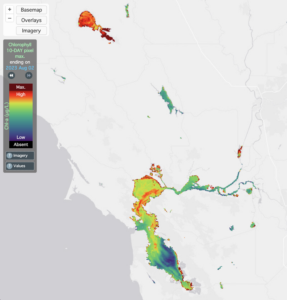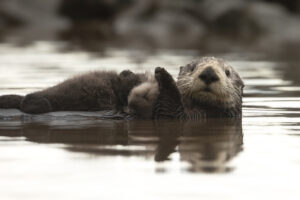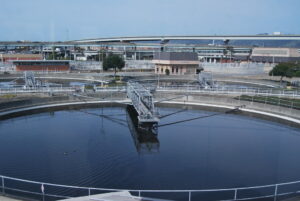Not long after the cargo ship Cosco Busan ran into the Bay Bridge last November, it was clear that the resulting spill was only the beginning of a much longer story. Volunteers flocked to shoreline parks and beaches, hoping to help. Most of them found that was no simple matter. The highly toxic oil posed serious health risks for untrained volunteers, and agency and law enforcement officials controlled access to many contaminated areas.
“It’s a really difficult thing to say to people, ‘I know you’re passionate, but there’s nothing to do,'” says Marylin Latta, habitat restoration manager for Save the Bay. “I almost had to go out and see and smell the fumes to convince myself of just how dangerous it was.”
The oil was indeed dangerous, and it moved quickly. By late morning on November 7, some of the more than 53,000 gallons of leaked fuel oil began to show up on the shores around San Francisco Bay. Within days, the slick had escaped the Bay and spread into the Pacific, eventually washing up on shorelines from Point Reyes to Half Moon Bay. Dozens of beaches were closed to the public; fishing for game fish, Dungeness crab, and other shellfish was suspended.
The state Department of Fish and Game stated that approximately half of the oil from the spill has now evaporated or been cleaned up, but that leaves 20,000 to 30,000 gallons of bunker oil at large in the sediment and waters of the Bay.
Within a week of the spill, government agencies and environmental organizations began a federally mandated Natural Resources Damage Assessment (NRDA) to quantify the impacts—and thus arrive at a financial cost for restoration. Though the information-gathering phase of the NRDA is still under way, many of the spill’s effects are now apparent.
The brunt of the immediate damage to wildlife was borne by waterbirds. Michael Ziccardi, executive director of the Oiled Wildlife Care Network (OWCN), says that nearly 1,100 live oiled birds were collected and treated by staff and more than 950 volunteers, who logged some 13,000 hours. (An additional 1,365 birds were dead on arrival at care facilities.) Fewer than 500 birds were successfully rehabbed and released, a testament to the oil’s potency. Hypothermia is the biggest threat to oiled birds: When oil penetrates to their skin, it compromises the water-tight layer that protects birds from chilly bay waters. “It’s like ripping a hole in a wetsuit,” explains Jay Halcomb, executive director of the International Bird Rescue Research Center. “A spot of oil the size of a dime can kill a bird.” Diving birds like grebes and scoters suffered the most, because they feed by plunging again and again through the oil-coated surface of the water.
In all, nearly 2,500 bird deaths were directly attributed to oil exposure, though Halcomb estimates that the actual number of dead may be ten times that, since many dead birds surely go undetected. The oil can also have longer-term toxic effects on birds that initially survive. They tend to preen incessantly, even at the cost of other necessities like feeding, and ingest significant quantities of oil in the process. “Ironically, the heavily oiled birds may stand a better chance, because we can catch them and take care of them,” says Halcomb.
Local eelgrass beds, important nursery zones for many fish and invertebrates in the shallow fringes of the Bay, also suffered. Though the Bay’s eelgrass beds were drastically depleted over a century ago by sedimentation from Gold Rush-era mining, there has been a modest resurgence in recent decades, thanks in part to concerted restoration efforts by Save the Bay, the Audubon Society, and others. But eelgrass, as a shallow-water plant, is particularly susceptible to surface oil, which concentrated into a sort of “bathtub ring” near the Bay’s edges.
In the first weeks after the spill, scientists tried to quantify the extent of the oil coverage. “We first tried looking at the beaches adjacent to eelgrass beds,” explains Katharyn Boyer, a wetlands ecology professor at San Francisco State University. But getting an accurate assessment wasn’t easy: Boyer had to wait until a low tide exposed the beds one night around Thanksgiving. Donning headlamps, she and a team of grad students raced from site to site, taking samples of the grass and resident invertebrates.
Of the Bay’s 3,000 acres of eelgrass beds, some 200 were moderately or heavily oiled. As with birds, physical coverage by oil is the main danger: Oiled eelgrass can’t perform photosynthesis, and covered shoots eventually die from lack of sunlight. Also, long after the surface oil washes away, plants that have absorbed petroleum show signs of wasting or bleaching. To determine the extent of this secondary effect, Boyer and other scientists are using a special technique to measure how well the plants are performing photosynthesis.
Other long-term effects may be even harder to quantify. The petroleum residue that spilled from the Cosco Busan, known as “Number 6 fuel oil,” or heavy bunker fuel, is a varied soup of hydrocarbons, sulfur compounds, and heavy metals like mercury. When released into a dynamic aquatic environment, it begins to separate into its constituent ingredients, explains Jen Kovecses, staff scientist for San Francisco Baykeeper, a nonprofit water quality advocacy group. The lighter parts remain at the surface, creating the gloppy slick that injured and killed so many birds. “The really worrisome fraction is more water soluble, and it contains the polycyclic aromatic hydrocarbons,” says Kovecses. These hydrocarbons are among the most toxic components of heavy bunker oil and can remain dissolved in the water for years. As such, they constitute a major ongoing threat to ecosystems throughout the Bay Area, but determining their full effect may be difficult or impossible. “Because oil spills are such diffuse threats, teasing out their effects from other [factors] can be a challenge,” says Kovecses.
Pacific herring, which lay their eggs in eelgrass beds and intertidal habitats, are especially susceptible to these hydrocarbons. “[The spill] was timed particularly badly for the herring,” says fisheries expert Michael McGowan, who explains that the release of oil coincided with their annual spawning season. Studies following the 1989 Exxon Valdez spill showed that herring eggs are affected by hydrocarbons and related chemicals, displaying high rates of mutation and disease. Because herring are the Bay’s largest commercial fishery, and baseline data is plentiful, they make a convenient indicator species for the NRDA. Moreover, fluctuations in their population are often mirrored in other shallow-spawning fish species, like grunion and some smelt. Historically home to one of the largest spawning populations of Pacific herring, the Bay experienced a sharp decline in estimated herring biomass during the 2007-2008 spawning season, down to 11,000 tons from the previous season’s 145,000 tons. Coupled with this decrease in adult population, the concentration of hydrocarbons in the Bay’s shallow-water spawning grounds leads many experts to predict bad years ahead for the herring.
The long-term impacts of the spill may be realized over years or decades. Many organisms will have to grapple with chronic effects as hydrocarbons left on sands and rocky shorelines continue to leach into the Bay. Marine mammals such as harbor seals, largely spared the acute effects of the spill by dint of population distribution and fortuitously timed pupping seasons, will have to deal with ongoing exposure as these pollutants move up the food chain.
With such a high volume of shipping in an environmentally sensitive region, the chances are high that the Cosco Busan spill won’t be the last insult to the health of the Bay. “With every release, we wonder, ‘Is this going to be the thing that puts us over the edge?'” says Boyer.
So continued monitoring is critical. Every bird released by OWCN is banded, and its movements tracked. Censuses on eelgrass, fish, and invertebrates continue. Such data will help determine the extent of the damage from this event and serve as a baseline following future incidents, just as monitoring over the preceding years served as a baseline for the current NRDA.
As with all undertakings of this magnitude, public involvement is key, and many more volunteers are needed to help gather the basic data through bird and fish counts and to assist with restoration of eelgrass and marsh habitats. “We were in awe of the public’s level of concern,” the bird rescue center’s Halcomb says. “They just weren’t going to put up with it.” OWCN has also seen a significant increase in the number of volunteers wanting to be trained so they’re prepared for the next spill. “At one point, we had almost twice as many people offering to volunteer as we had oiled birds,” says OWCN’s Ziccardi, adding that that enthusiasm hasn’t disappeared. “If you show people how they can help, they’ll surprise you with how much they’re willing to contribute.”
Many organizations are looking for volunteers, including:
bayevents@saveSFbay.org, (510)452-9261
eliet@baykeeper.org, (415)856-0444 ext. 101
International Bird Rescue Research Center: info@ibrrc.org, (707)207-0380
Oiled Wildlife Care Network: (530)752-5603
Richardson Bay Audubon: (415)388-2524

.jpg)



